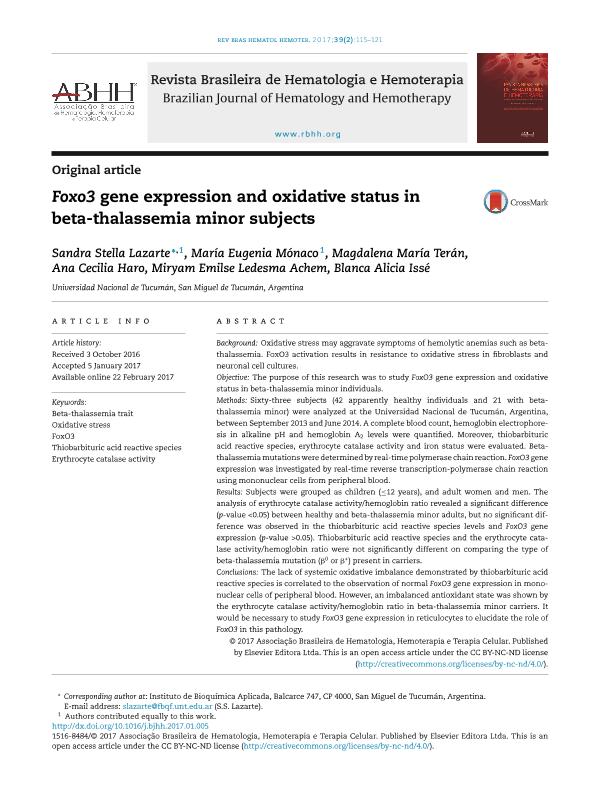Artículo
Foxo3 gene expression and oxidative status in beta-thalassemia minor subjects
Lazarte, Sandra Stella; Monaco, Maria Eugenia; Teran, Magdalena María ; Haro, Ana Cecilia
; Haro, Ana Cecilia ; Ledesma, Miryam Emilse; Isse, Blanca Alicia de Los Angeles G.
; Ledesma, Miryam Emilse; Isse, Blanca Alicia de Los Angeles G.
 ; Haro, Ana Cecilia
; Haro, Ana Cecilia ; Ledesma, Miryam Emilse; Isse, Blanca Alicia de Los Angeles G.
; Ledesma, Miryam Emilse; Isse, Blanca Alicia de Los Angeles G.
Fecha de publicación:
04/2017
Editorial:
Associação Brasileira de Hematologia, Hemoterapia e Terapia Celular
Revista:
Revista Brasileira de Hematologia E Hemoterapia
ISSN:
1516-8484
e-ISSN:
1806-0870
Idioma:
Inglés
Tipo de recurso:
Artículo publicado
Clasificación temática:
Resumen
Background Oxidative stress may aggravate symptoms of hemolytic anemias such as beta-thalassemia. FoxO3 activation results in resistance to oxidative stress in fibroblasts and neuronal cell cultures. Objective The purpose of this research was to study FoxO3 gene expression and oxidative status in beta-thalassemia minor individuals. Methods Sixty-three subjects (42 apparently healthy individuals and 21 with beta-thalassemia minor) were analyzed at the Universidad Nacional de Tucumán, Argentina, between September 2013 and June 2014. A complete blood count, hemoglobin electrophoresis in alkaline pH and hemoglobin A2 levels were quantified. Moreover, thiobarbituric acid reactive species, erythrocyte catalase activity and iron status were evaluated. Beta-thalassemia mutations were determined by real-time polymerase chain reaction. FoxO3 gene expression was investigated by real-time reverse transcription-polymerase chain reaction using mononuclear cells from peripheral blood. Results Subjects were grouped as children (≤12 years), and adult women and men. The analysis of erythrocyte catalase activity/hemoglobin ratio revealed a significant difference (p-value <0.05) between healthy and beta-thalassemia minor adults, but no significant difference was observed in the thiobarbituric acid reactive species levels and FoxO3 gene expression (p-value >0.05). Thiobarbituric acid reactive species and the erythrocyte catalase activity/hemoglobin ratio were not significantly different on comparing the type of beta-thalassemia mutation (β0 or β+) present in carriers. Conclusions The lack of systemic oxidative imbalance demonstrated by thiobarbituric acid reactive species is correlated to the observation of normal FoxO3 gene expression in mononuclear cells of peripheral blood. However, an imbalanced antioxidant state was shown by the erythrocyte catalase activity/hemoglobin ratio in beta-thalassemia minor carriers. It would be necessary to study FoxO3 gene expression in reticulocytes to elucidate the role of FoxO3 in this pathology.
Archivos asociados
Licencia
Identificadores
Colecciones
Articulos(CCT - NOA SUR)
Articulos de CTRO.CIENTIFICO TECNOL.CONICET - NOA SUR
Articulos de CTRO.CIENTIFICO TECNOL.CONICET - NOA SUR
Articulos(INBIOFAL)
Articulos de INSTITUTO DE BIOTECNOLOGÍA FARMACEUTICA Y ALIMENTARIA
Articulos de INSTITUTO DE BIOTECNOLOGÍA FARMACEUTICA Y ALIMENTARIA
Citación
Lazarte, Sandra Stella; Monaco, Maria Eugenia; Teran, Magdalena María; Haro, Ana Cecilia; Ledesma, Miryam Emilse; et al.; Foxo3 gene expression and oxidative status in beta-thalassemia minor subjects; Associação Brasileira de Hematologia, Hemoterapia e Terapia Celular; Revista Brasileira de Hematologia E Hemoterapia; 39; 2; 4-2017; 115-121
Compartir
Altmétricas



